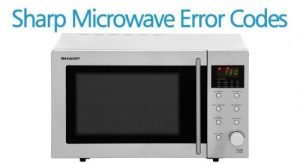
Now, before you start worrying about costly repairs or having to replace your trusty kitchen gadget, take a deep breath. The “LE” error code is typically fixable. It often results from minor glitches in the control panel or issues within the electrical circuitry. Sometimes, it’s as simple as a temporary error that a quick reset can solve. Picture it as having a minor hiccup in your smartphone—sometimes, a simple restart does the trick.
But what exactly causes this error in the first place? Could you have done something to prevent it? Let’s explore the ins and outs of the “LE” error code and what you can do to troubleshoot it effectively.
Understanding the “LE” Error Code
The “LE” error code is essentially the microwave’s way of alerting you to potential issues with the communication between its internal components. Imagine your microwave’s touchpad as its brain and the control board as its nervous system. If there’s a miscommunication between the two, the “LE” error pops up.
In most cases, this error might occur due to a faulty door switch. Just like how a fridge light needs the door to be properly shut to turn off, a microwave requires its door to be securely closed to operate. If the door switch is defective, the microwave might mistakenly think the door is open, and this can trigger the “LE” code. Additionally, electrical surges or moisture can affect the control board, leading to these error messages.
You might find this scenario familiar: you’ve just finished heating your meal, but the microwave refuses to do more, showing an “LE” instead. Although this issue can be frustrating, understanding its causes can make troubleshooting much simpler.
How to Troubleshoot the “LE” Error Code
Okay, here’s the deal: tackling the “LE” error code doesn’t necessarily mean you need to call a repair technician right away. In many cases, you can resolve it with a few easy steps. Firstly, try performing a soft reset. Unplug the microwave from the power source, wait a couple of minutes, and then plug it back in. This process is akin to rebooting your computer when it’s acting up—it helps clear temporary glitches.
If the reset doesn’t work, take a closer look at the microwave door. Ensure it closes properly, and the latches are not obstructed. Sometimes, debris or a slightly loose latch can trick the microwave into showing an error. Imagine trying to turn on a car that thinks its doors are open; ensuring everything is correctly sealed is key.
Furthermore, check for any visible damage. Examine the control panel for signs of wear or moisture. Excess humidity, particularly in the kitchen, can sometimes lead to these errors. If everything seems in order and the error persists, it might be time to contact a professional. They can help with more complicated fixes, like replacing the control board.
Preventing Future “LE” Errors
Prevention, as they say, is better than cure. To minimize the chances of encountering the dreaded “LE” error code in the future, there are a few handy tips you can keep in mind. Always ensure your microwave is kept dry and clean. Moisture and food particles can sometimes sneak into places they shouldn’t, so regular cleaning can be a lifesaver.
Additionally, make sure you’re closing the microwave door gently. Slamming it can not only wear out the door mechanism but also eventually cause alignment issues that might trigger errors. Think of it like slamming your phone down on a table; over time, it’s bound to show signs of wear.
Finally, consider investing in a surge protector. Electrical surges aren’t just a hazard for computers and TVs; they can also affect kitchen appliances. A surge protector provides that added layer of defense, helping to keep your microwave working smoothly.
In conclusion, while the “LE” error code on your Sharp microwave might seem annoying, it’s often a quick fix. By understanding what it means, how to troubleshoot it, and ways to prevent it, you can keep your microwave humming along happily. Remember, a little bit of care goes a long way in maintaining your kitchen equipment’s longevity.